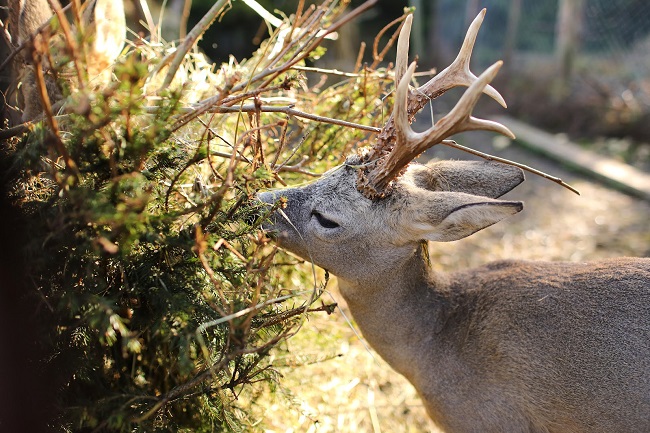
While deer are an important part of the local ecosystem, they can cause a lot of damage to property if left unchecked. Vehicle collisions, crop and landscape damage, and suppressed forest regeneration are problems that can occur when deer congregate near manmade structures.
Here are strategies you can utilize to help mitigate deer inflicted damages.
Fencing
High fence installation is the most effective long-term solution to prevent deer damage. Deer are capable of jumping over a 10-foot high fence, but they often choose to go under in most cases. For this reason, standard fences must be no more than 6 inches off the ground. Electric fences on the other hand must be no more than 10 to 12 inches above the ground.
Your high fence must be maintained, and any damage should be repaired immediately. Once deer have penetrated the fence, it is difficult to keep them out. Gaps and gates must be closed at all times.
The fence must be visible and should have a clear perimeter. Deer may accidentally run into fences and damage sections if they were not aware it was there.
Electric Fences
Electric fencing need not be a huge investment. Smaller properties can be protected by portable electric fences which can be installed and taken down all on the same day. Owners of larger fields who want to put up permanent electric fences can cut down on costs by investing in solar chargers.
Portable electric fences can use regular electric wire or hot tape, a wide colored tape embedded with wires. It is visible at night and generates an electric shock on contact.
Enhance your electric fence’s effectiveness by baiting it. Adding a metal tab smeared with peanut butter will lure deer in to approach the fence. By licking the peanut butter its nose and tongue, the deer will be trained to stay away from the fence. Maintain a 30-foot distance between tabs and keep it baited for several weeks after the high fence installation. Otherwise, you may never know if deer will test the fence that shocked them or if there’s a new herd in the area.
Above all, keep your electric fence charged at all times.
Hunting
Hunting effectively controls deer populations, which reduces the risk of damages.
Out-of-season shooting permits are issued for properties experiencing extensive deer damage and crop losses outside the normal deer hunting season. This permit is only valid within a specific time frame as determined by a local wildlife biologist.
Deer Management Assistance Permits (DMAPs) are issued during deer hunting season only. These permits are valid for antlerless deer and are intended to help individuals reduce future crop damage by decreasing the deer population on their property.
A site visit may be required to assess the extent of the damages. The harvested deer may either be kept or donated.
Deer Repellants
Deer have a strong sense of smell. Deer repellants emit scents that falsely alert deer to predators, which keeps them away.
Please note that repellants may not work 100 percent of the time. For best results, test them out during different times of the year and combine these with other preventive strategies.
Liquid Fence. This liquid concentrate produces an odor that repels deer. For crop applications, make sure to use a non-toxic formulation. Re-apply Liquid Fence after a downpour, as rain washes it out and reduces its potency.
Blood Meal. Made from dried animal blood, this high-nitrogen fertilizer has proven to be an effective deer deterrent. Blood meal is often used in orchards and is applied to areas that can potentially attract deer.
Human hair. The scent of human hair is believed to keep deer away. Place hair in mesh bags and hang these on trees and shrubs at the onset of spring; these bags should be no more than three feet apart and should be replaced monthly.
Soap. Wrap highly scented, tallow-based soap bars in mesh or cheesecloth and hang them within three feet of the plants you want to protect from deer.
Scare Tactics
Use scare tactics sparingly as deer can eventually get used to these. Like repellants, combine scare tactics with other measures as these can be ineffective in the long run when used on their own. Scare tactics should also be used with discretion; some might be practical for rural settings but could be a nuisance in suburban areas because of the noise they create.
Siren screamers. These emit a loud, siren-like noise that scares deer off. You can get siren screamers and the device used to fire them from your local wildlife office.
Flagging. Deer are naturally sensitive to movement. Objects that move with the wind, such as strands of Mylar tape hung from stakes, have been used to prevent deer damage.
Flashing and strobe lights. Lights startle deer at night when they are more likely to cause damage.
Motion-activated water sprinklers. Sensors detect movement from up to 40 feet away, which triggers a spray of water. This not only deters deer but smaller critters, too.
Straight Shooter Game Fencing works with property owners throughout the US to provide the best high fence installation, service, and fencing materials at competitive prices. Get in touch with us to know more.
